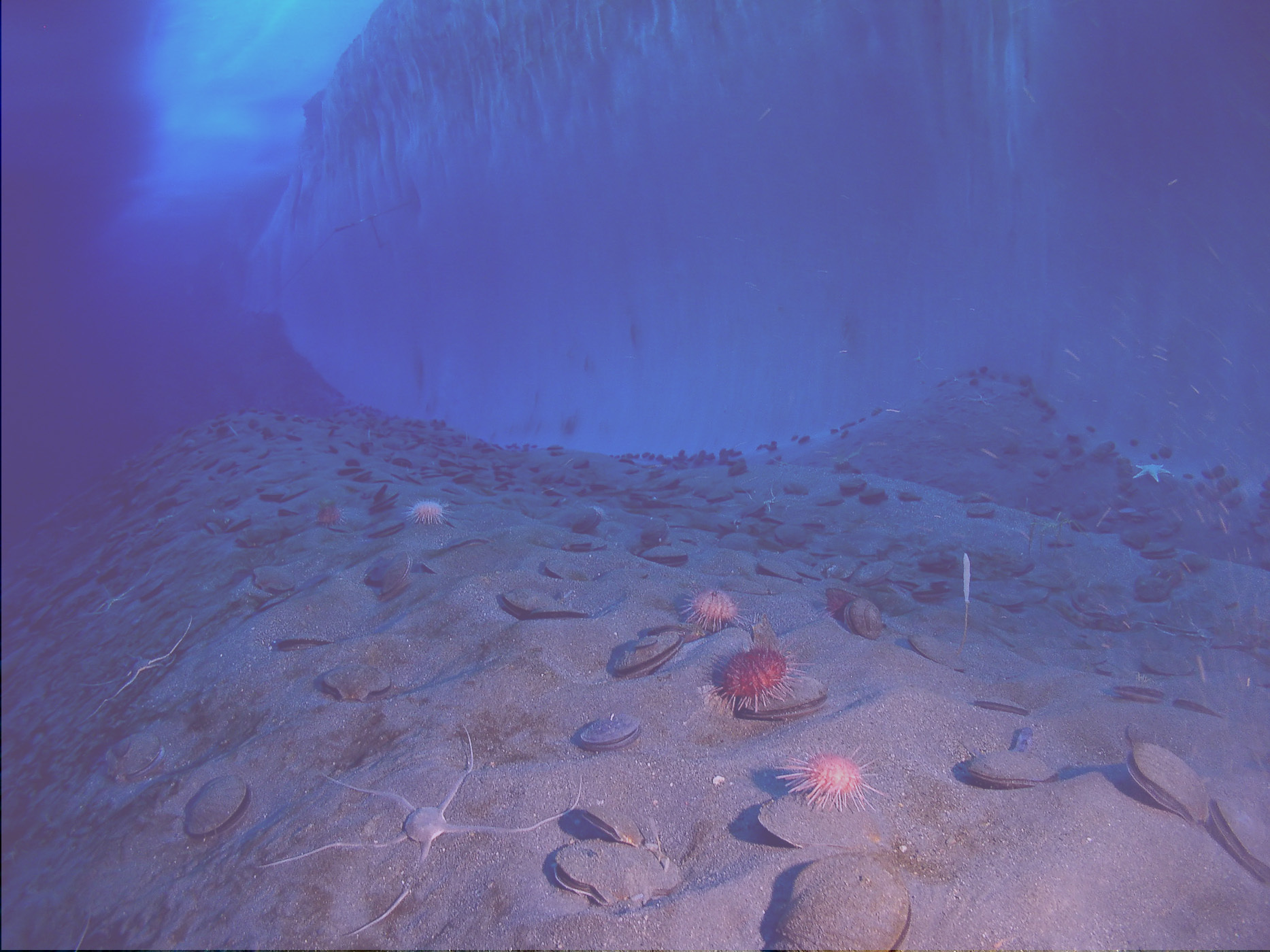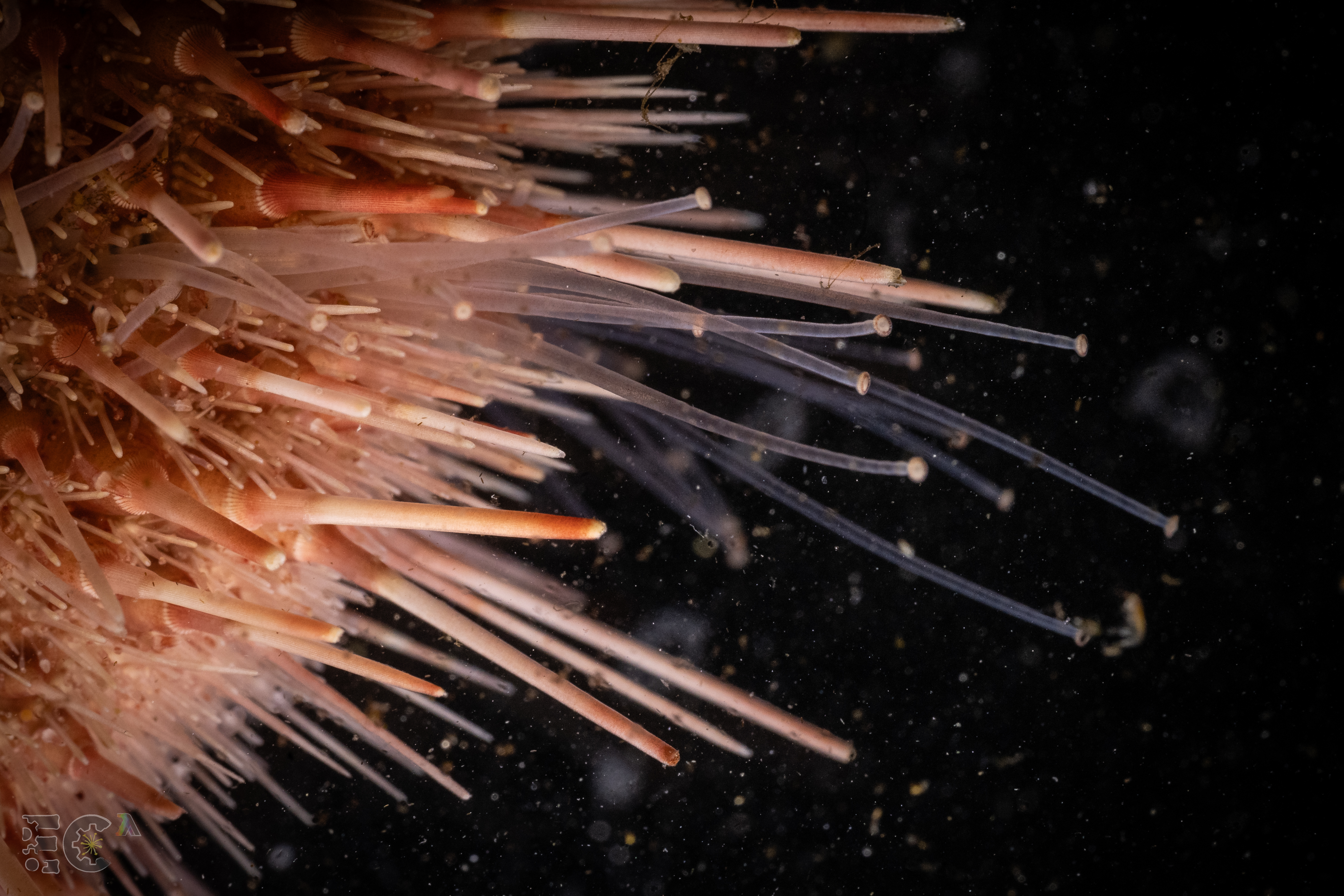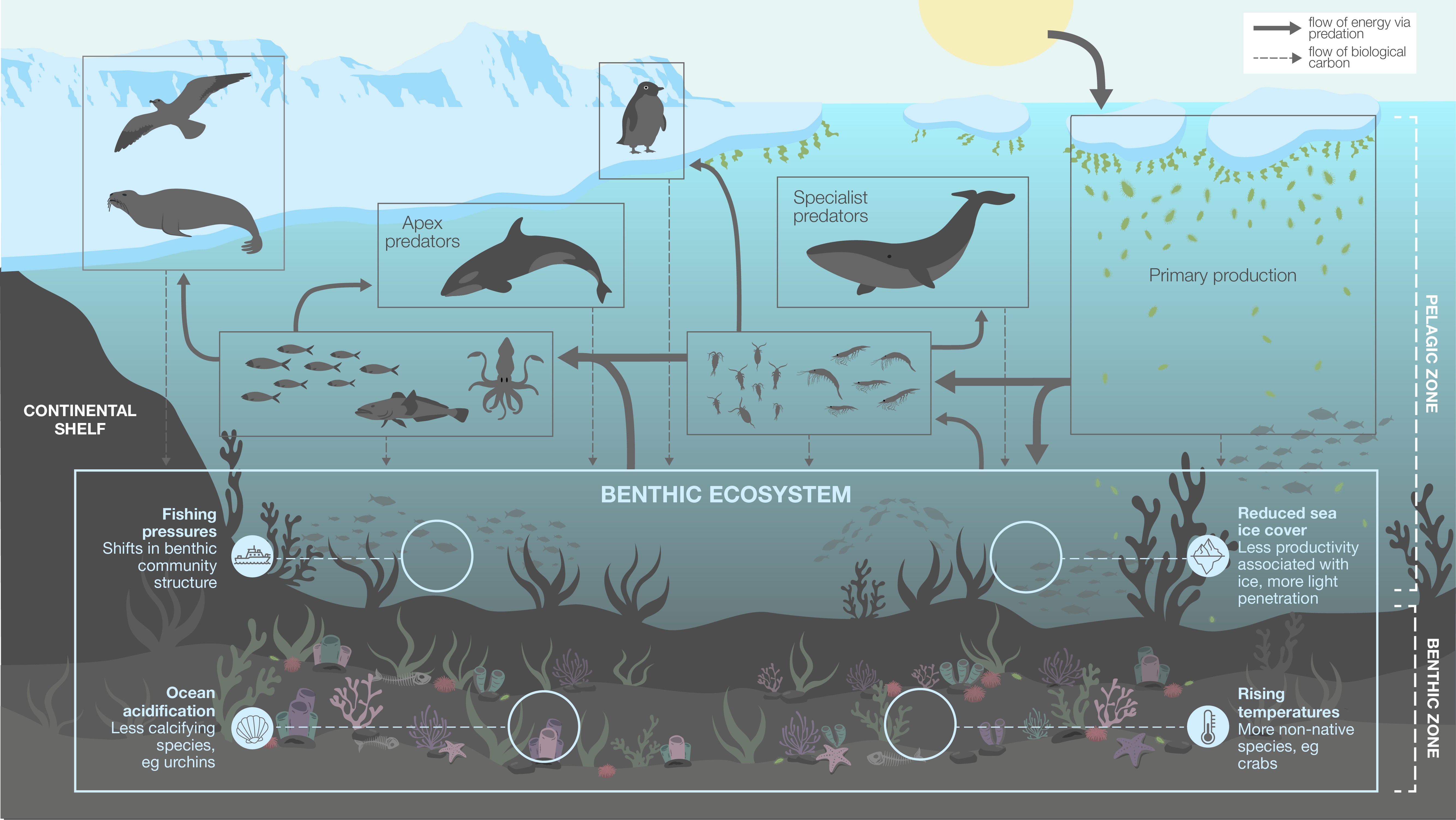
A living laboratory: Antarctica’s Ross Sea benthic communities
The Antarctic seafloor and its inhabitants (the benthic ecosystem) are affected by a changing physical environment, including warming and acidifying oceans, sea-ice loss, ice shelf retreat, and extreme weather events. These changes will result in winners and losers among ecologically important benthic species, which in turn will alter marine biodiversity and food webs. Studying this ‘living laboratory’ provides insights on potential impacts of climate change, and informs ecosystem protection and management.
This summary
This summary aims to inform policy makers and scientific peers about benthic research conducted in the Ross Sea region by New Zealand’s Antarctic Science Platform (ASP).
This research synthesis:
- shares fundamental information about Antarctica’s benthic habitats
- highlights the effects of a changing climate on benthic ecosystems in the Ross Sea region
- provides critical baselines and new insights to understand benthic biodiversity and biogeography in a warming world
- provides examples of how the research can be applied by domestic and international collaborators to advance science, environmental management and ecosystem resilience
Key points
- Ross Sea region in Antarctica is significant for its near-pristine environment, unbroken food chain, and unique biodiversity. The Victoria Land coast supports diverse benthic habitats and communities, and is recognised as an area of ecological importance in the Ross Sea region Marine Protected Area.
- Environmental change can trigger abrupt community responses in coastal waters. Impacts of a warming climate on Antarctic benthic communities are already being seen.
- Tipping points are likely to be reached over the coming decades. Ecological signposts are needed to signal shifts in system stability and to indicate imminent change.
- There is a strong link between sea ice and ecosystem primary productivity pathways.
- New field samples and data, and the use of remote technologies, are being used to analyse and detect the impact of multiple stressors, and to gain new information on the adaptive capacities of polar species to change.
Research targets signposts of change
Extreme climatic events and rapid glacial retreat can trigger abrupt responses in biological communities living in coastal waters. The direct and indirect consequences of changing sea ice and other environmental parameters (for example, productivity, ocean temperature, salinity, circulation, and biogeochemistry) on benthic ecology is complex and involves multiple processes.
Coastal seafloor communities are directly linked with pelagic (open ocean) ecosystems in the Southern Ocean, the northern part of which is part of New Zealand’s Exclusive Economic Zone. Antarctic benthic ecosystems are critical to the Antarctic food web and the integrity of the marine ecosystem.
Research to date shows that important ecosystem components of Antarctica and the Southern Ocean are already experiencing climate change impacts. We have gained insights into which processes, regions, and organisms in the Ross Sea must be observed to understand the future of Antarctica’s coastal ecosystems. We know that climate change will create winners and losers among ecologically important species – altering biodiversity and primary production, as well as ecosystem functions. Signposts are needed to signal imminent shifts in system stability.

Photo: Emiliano Cimoli
Benthic Ecology research
Scientists have identified research priorities
ASP researchers joined other Antarctic experts, under the umbrella of one of the Scientific Committee for Antarctic Research’s scientific research programmes, ‘Antarctic Thresholds-Ecosystem Resilience and Adaptation’. The team synthesised knowledge on the impacts and risks of climate and other environmental change on biological processes and ecosystem functions in the Antarctic.
This review showed that life in the Southern Ocean and Antarctica is highly sensitive to environmental changes, and that the responses of Antarctic ecology to environmental changes varies considerably across regions, habitats, ecosystems, communities and organisms.
Priorities for future research include the impacts of accelerating biogeochemical cycles (the movement and transformation of chemical elements and compounds between living organisms, the atmosphere, and the Earth), ocean acidification, biodiversity shifts, changing sea ice conditions, and pollution.
Field observations improve understanding and future projections
Technology advances research
The use of non-intrusive and remote technologies to study benthic habitats has been one of the great successes from the Antarctic Science Platform. Researchers are using techniques that have helped to accelerate the gathering of data and, in turn, the understanding of the Ross Sea benthic ecosystem. These techniques can help develop spatially explicit projections for the future and identify key ecological functions.
Specific techniques include:
- an increased use of autonomous sampling platforms, including unmanned underwater vehicles, both towed and remotely piloted, to capture images at depth, combined with AI tools to expedite analysis of video sampling
- analyses of environmental DNA (an example uses minute traces of DNA trapped by filter-feeding sponges to reveal a snapshot of what is present in an ecosystem)
- using underwater hyperspectral survey methods with AI-based image analysis to non-invasively detect the presence and coverage of marine algae
- use of satellite-derived information to quantify sea-ice conditions, water temperature and phytoplankton biomass.
- deployment of coastal seafloor monitoring stations to understand the environment surrounding benthic communities

Figure 1: Arrows show the flow of energy to and from the benthic ecosystem, which is connected throughout the entire food web. Circles indicate the drivers of change facing the ecosystem.
Our research is an important part of global understanding and action
Current knowledge on the human footprint is essential to inform Antarctic Treaty policy and national legislation to ensure healthy Antarctic ecosystems. This knowledge justifies an extended protection of Antarctic species from the risks of climate change, pollution, and other disturbances.
Over the course of the ASP, we have developed new techniques to enhance coverage and understanding of benthic communities, through increased use of ROVs and towed cameras. This allows larger areas to be surveyed and to greater depths. Integration of eDNA into analyses allows rapid, semi-automated assessment of species presence, combined with the physical observations to validate eDNA inferences.
Collaborations with international scientists bring new insights and technologies to our research. By combining sea ice- and vessel-based research, we have spread our understanding from the McMurdo Sound to the full length of the Victoria Land coast in never-before surveyed locations. This represents a major north-south transect that spans environmental gradients and several biogeographic regions. We have sampled multiple sites on more than one occasion, building valuable time series. Such an extensive sample set is rare and provides an important legacy; a critical set of baseline research material taken at the beginning of a changing regime within the Ross Sea.
Definitions
Benthic: living in, on, or near the seafloor and its sediments.
Pelagic: inhabiting or relating to the open ocean or high seas.
Ecosystem resilience: the capacity of an ecosystem to absorb disturbances and stresses whilst retaining its basic function.
Biogeochemical cycles: pathways by which essential elements and compounds (like carbon, nitrogen, and water) are cycled between living organisms and their non-living environment.
References
Byrne M, Lamare MD (2024). Climate change and polar marine invertebrates: life‑history responses in a warmer, high CO2 world. Journal of Experimental Biology 227(23). https://doi.org/10.1242/jeb.24...
Griffiths HJ, Anker P, Linse K, Maxwell J, Post AL, Stevens C, Tulaczyk S, Smith JA (2021). Breaking All the Rules: The First Recorded Hard Substrate Sessile Benthic Community Far Beneath an Antarctic Ice Shelf. Frontiers in Marine Science 8:642040. https://doi.org/10.3389/fmars....
Griffiths HJ, Cummings VJ, Van de Putte A, Whittle RJ, Waller CL (2024). Antarctic benthic ecological change. Nature Reviews Earth & Environment 5: 645–664. https://doi.org/10.1038/s43017...
Gutt J, Isla E, Xavier JC, Adams BJ, Ahn I‑Y, Cheng C‑H, Colesie C, Cummings VJ, di Prisco G, Griffiths H, Hawes I, Hogg I, McIntyre T, Meiners KM, Pearce DA, Peck L, Piepenburg D, Reisinger RR, Saba GK, Schloss IR, Signori CN, Smith CR, Vacchi M, Verde C, Wall DH (2020). Antarctic ecosystems in transition – life between stresses and opportunities. Biological Reviews 95(6): 1695–1727. https://doi.org/10.1111/brv.12...
Jeunen GJ, Mills S, Lamare M, Duffy GA, Knapp M, Stanton JA, Mariani S, Treece J, Ferreira S, Durán‑Vinet B, Zavodna M, Gemmell NJ (2024). Unlocking Antarctic molecular time‑capsules – recovering historical environmental DNA from museum‑preserved sponges. Molecular Ecology Resources 24(7). https://doi.org/10.1111/1755-0...
Jeunen G‑J, Mills S, Mariani S, Treece J, Ferreira S, Stanton JLA, Durán‑Vinet B, Duffy GA, Gemmell NJ, Lamare MD (2024). Streamlining large‑scale oceanic biomonitoring using passive eDNA samplers integrated into vessel’s continuous pump underway seawater systems. Science of the Total Environment 946. https://doi.org/10.1016/j.scit...
Lamare M, Byrne M, Danis B, Deaker D, Di Luccio M, Dupont S, Foo SA, Jowett T, Karelitz S, Sewell MA, Thomas LJ, Agüera A (2024). Antarctic cushion star Odontaster validus larval performance is negatively impacted by long‑term parental acclimation to elevated temperature. Science of the Total Environment 956. https://doi.org/10.1016/j.scit...
Lohrer AM, Norkko AM, Thrush SF, Cummings VJ (2021). Climate cascades affect coastal Antarctic seafloor ecosystem functioning. Global Change Biology 27(23): 6181–6191. https://doi.org/10.1111/gcb.15...
Montes‑Herrera JC, Cimoli E, Cummings VJ, D’Archino R, Nelson WA, Lucieer A, Lucieer V (2024). Quantifying pigment content in crustose coralline algae using hyperspectral imaging: a case study with Tethysphytum antarcticum (Ross Sea, Antarctica). Journal of Phycology 60(3). https://doi.org/10.1111/jpy.13...
Perry F, Duffy GA, Fraser CI, Grant A, Lamare MD (2024). Kelp holdfast microclimates buffer invertebrate inhabitants from extreme temperatures. Marine Environmental Research 196: 106523. https://doi.org/10.1016/j.mare...
Spencer HG, Fraser CI, Poulin E, González-Wevar CA (2025). Towards a more nuanced understanding of long‑distance rafting: Case studies from the Southern Ocean. Global Ecology & Biogeography 34. https://doi.org/10.1111/geb.70...
Tait LW, Chin C, Nelson W, George S, Marriott P, O’Driscoll RL, Lamare M, Mills VS, Cummings VJ (2024). Deep‑living and diverse Antarctic seaweeds as potentially important contributors to global carbon fixation. Communications Earth & Environment 5: 205. https://doi.org/10.1038/s43247...
Wood RA, Baker JA, Beaugrand G, Boutin J, Conversi A, Donner RV, Frenger I, Goberville E, Hayashida H, Koeve W, Kvale K, Landolfi A, Maslowski W, Oschlies A, Romanou A, Somes CJ, Stocker TF, Swingedouw D (2024). Opportunities for Earth Observation to Inform Risk Management for Ocean Tipping Points. Surveys in Geophysics 46: 443–502. https://doi.org/10.1007/s10712...